Yeti Skulls, Hospitals and the Highest Hotel in the World
Yeti Skulls, Hospitals and the Highest Hotel in the World*
Everest Base Camp The Lazy Way: Day 5
We have observed the main trail to Everest Base Camp leading out of Namche Bazar. Zig-zagging straight up a 60 degree slope for an hour or so’s walking it looks, well, hard on the limbs, frankly.
So we are super-chuffed that we’re taking the scenic, longer route up the Gokyo Valley, rather than a savagely corrugated hike up to Tengboche, and even more chuffed that Nir knows a route that doesn’t go straight up the side of a bloody hill.
Hard as it is to leave behind the sophisticated pleasures of Namche Bazar – it has an Irish pub! And WINE! – I’m thanking my lucky stars for the magic maths of altitude and acclimatisation.
There are various formulations of this, but the rule we’re following is the one we were given in Kathmandu, which is to sleep no more than 300 or so metres higher than you did the night before, and spend an extra day acclimatising at the same level for every 1000m increase in elevation.
Which is a roundabout way of saying that, because Khumjung is at 3780m, or 340m higher than Namche, it’s our natural acclimatisation stop en route up the valley.
And we’re only going to have to walk a couple of hours to get there.
Well, at least that’s what Nir says.
Also, as I believe I mentioned, Khumjung has a monastery with a yeti skull. And, let’s face it, life doesn’t get more Himalayan than that! (Well, at least not until Machhermo, which, Nepali maps inform one solemnly, is the place where a yeti killed three yaks and attacked a Sherpa woman in 1974.)
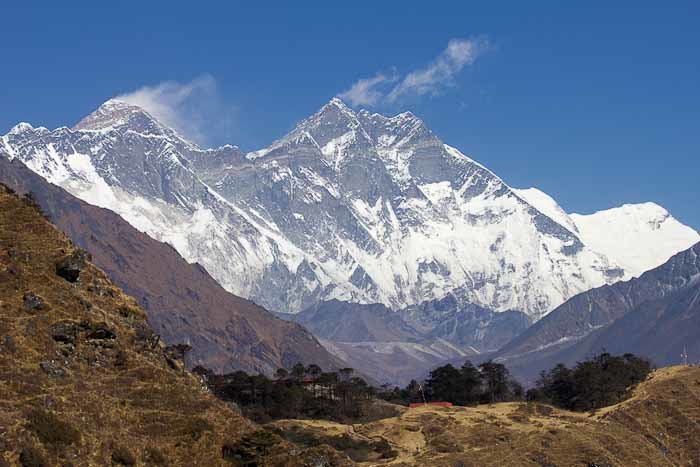
Our first stop, naturally, is the highest hotel in the world (ASTERISK), the Everest View Hotel. Because, as a sucker for signs (unlike my son), there are few things nicer than breaking for coffee at the highest/lowest/tallest/biggest ANYTHING.
We are settling, already, into a pleasant rhythm of rising at some point between 8 and 8.30, when the sun is taking the edge off the night chill, breakfasting at 8.30 (porridge and delicious yakalo milk coffee for me, porridge and hot lemon for the boy), and starting walking at 9ish, by which point the sun is fully up.
By that time, although you want a hat and snood to mitigate the impact of the air temperature on the ears and respiratory system, a double fleece open over a T-shirt will do us just fine for warmth.
We take the easy route out of town, climbing above the mani stones that mark the junction past the monastery.
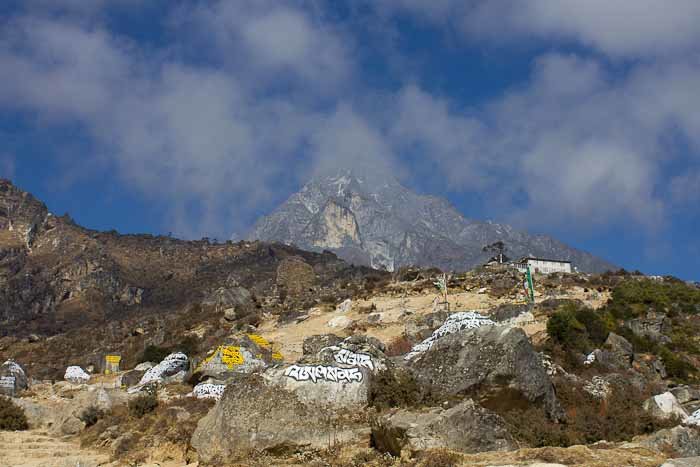
Easy, in this instance, being relative. It’s a “little bit up”, says Nir.
China’s Tiger Leaping Gorge has a stretch called 28 Bends that is considered difficult. I start counting this series of bends quite a way up, and make it to 23.
However… Our legs don’t hurt. Our lungs don’t hurt. And I feel like I’m breathing deeply and solidly rather than panting or breathless (weirdly, it’s at rest that I find myself catching my breath, as though I’ve forgotten to breathe for a couple of seconds and have to take a few deep breaths to catch up – this is, apparently, called periodic breathing, and is something most people get at altitude).
And, when we reach the top, it’s with relief, rather than a sense of collapse. And mild awe.
For, yea, we have found an airstrip more scary than Lukla – Syangboche, a patch of grass descending vertiginously to the edge of a gorge, and used, mercifully, only by rescue choppers and scenic flights.
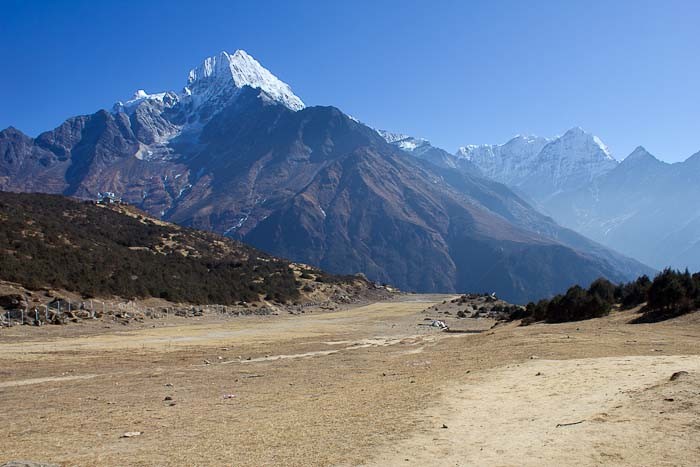
The Hotel Everest View is a peculiar place, in a dazzling situation, nestled amid tall firs in a meadow on the top of this particular ridge. It has an upscale, modernist alpine feel to it, and, Zac and I both feel, a distinct dose of The Shining, thanks to the long, red-carpeted and rather empty corridors, and general air of neglect.
Sitting on the terrace, though, watching the jet-stream blasting a plume of snow high above Mount Everest, and sipping a decent coffee, is very charming.
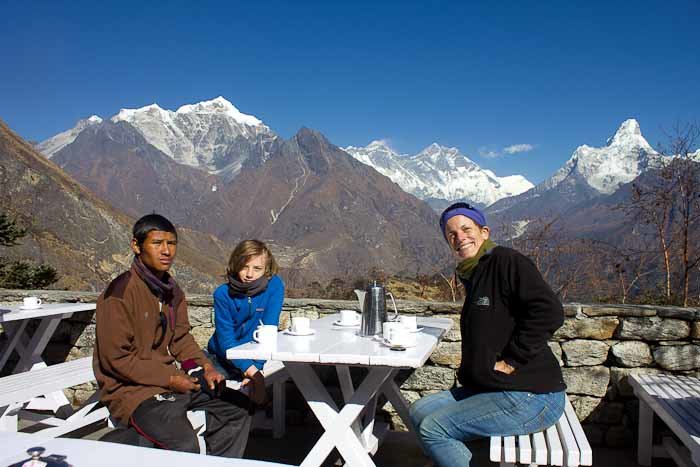
So charming, in fact, that I decide to check out a room, perhaps as a celebration spot for when we manage the Cho-La pass (difficult, we’re told) and Everest Base Camp (a relative cakewalk).
Someone scrapes together a key, and the three of us troop down the chilly, red-carpeted corridors.
“Do the rooms have hot water?” I ask.
“Not in the room,” says the chap. “You need to use a bucket.” (I missed my last chance for a hot non-bucket shower in Namche. Zac will not be washing for the duration.)
The view from the broad windows is stunning. The carpet’s a little bit tatty, the quilts no more stylish than the quilts in our 200 rupee a night room, and the two single beds no wider, but there is a fan heater to take the edge off the temperature (though not to lounging in a negligee warmth) and a sunny little terrace on which to dine of a morning.
Yep, I think. I could run to fifty bucks for this. Or even fifty quid at a splurge.
“How much is the room?” I ask.
“275,” says the guy, without specifying currency.
I run the currency maths. It is either well over one hundred times what we are currently paying for a room, or under 50% more. Neither seems correct. “Dollars?” I ask.
“Dollars,” he says. Nir emits a strangulated snirking noise. Zac’s jaw hits the floor.
“Thank you,” I say with as much dignity as I can muster.
“All meals included,” the guy says optimistically.
“Wow!” says Zac later, as we amble down a sandy hillside lined with pines and juniper. “You could get a room in the Savoy for that, just about.”
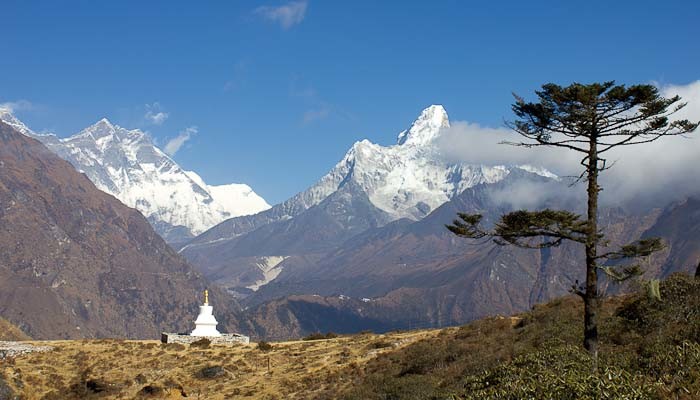
A rather splendid pair of chortens appear before us, decked with bright prayer flags, and views extend to the beautiful Ama Dablam, my current favourite mountain, like a witch’s finger or an upside down Mr Wot, in the distance.
Below us stretches what is, by Himalayan standards, a substantial conurbation of perhaps a hundred buildings surrounded by dry stone fields.
“Khumjung,” says Nir.
“Khumjung?!” I say. “We’re HERE? ALREADY?!”
“Yes,” says Nir. “Two hours!”
“Fantastic!” I say.
We’re at the very beginning of December, the start of the off-season, and it looks like we’re the only people in our guest-house. We dump our bags in our little room with its twin beds, bright quilts and bright curtains, eat lunch in the warm sun room lined with certificates and signed posters from expeditions, and admire the paintings of the son of the house.
Then we head out to explore the metropolitan delights of Khumjung and Kunde, which appear as separate villages on my map but have basically joined into a blur since then.
First up? The monastery with the yeti skull, natch.
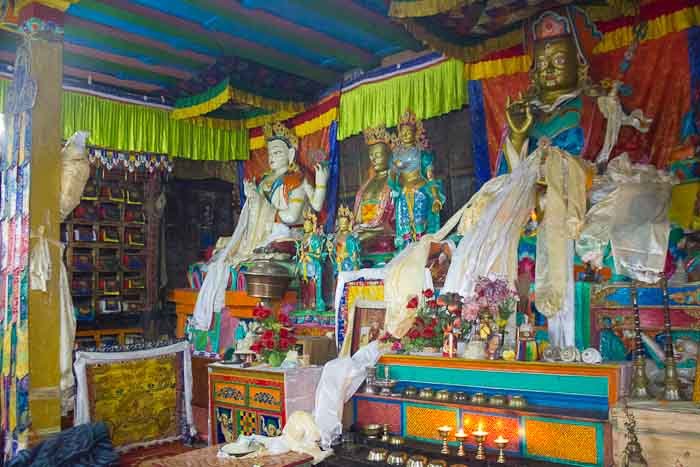
I love the colourful, even gaudy, paintings, silk hangings, scrolls, statuary and sculpture that come with Tibetan (and, whisper it, Chinese) Buddhism, and Khumjung Monastery, one of the Khumbu’s older gompas, does not disappoint.
At the heart of the action, though, is not the glorious Buddha or the wonderful holy scrolls, but a grey-painted cannibalised electricity junction box which houses – YES! – the yeti skull.
Zac and I scrutinise the account of the skull’s presence here, which has the incoherence of a truly old folk myth (and then the villagers of Tengboche kicked it down the hill, and the lama said…), and we read about the yeti’s physique, and uniquely conical skull.
We make a donation – I start with 100 rupees, Nir recommends 50 – and the lay attendant unlocks the safe to reveal a padlocked glass box containing, well, the conical top of a yeti skull.
It is every bit as convincing as the burning bush we saw in Saint Catherine’s Monastery in the Sinai, and I am, wholeheartedly, every bit as glad to have seen it.
We admire its gleaming, not-at-all-glued-on pelt (scientifically identified as that of an antelope in the 1960s) for a diplomatic period, grab a shot and head on out into the mist which has rolled up the valley.
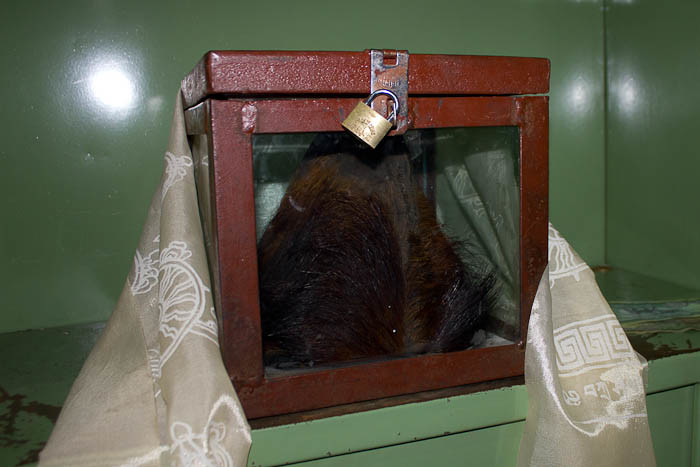
Our next stop? The hospital in Khunde, which still appears on our map as a separate village, but has pretty much joined up with its neighbour.
Both Edmund Hillary and Tenzing Norgay, who became the first people to summit Everest and survive in 1953, and probably the first people to summit Everest ever (the jury remains out on whether Mallory and Irvine died on the way to the top or on the way down from it a generation before), are heroes throughout the Solo-Khumbu region.
Lukla airport is named for them, decorative gates commemorate them and no museum, however small, is complete without photos of the pair of them.
Now, I knew, of course, about Hillary.
But I’d had no idea that he spent decades of his life doing good works in the region.
On his return to Everest, you see, the Sherpa nobbled him and asked him to build the region’s first school. He did this (and has, with his foundation, since built 40 more).
The next request? A hospital, natch.
And it’s this, a long, narrow, single-storey breezeblock building with prayer flags and gleaming solar array, that we’re wandering through the village to see.
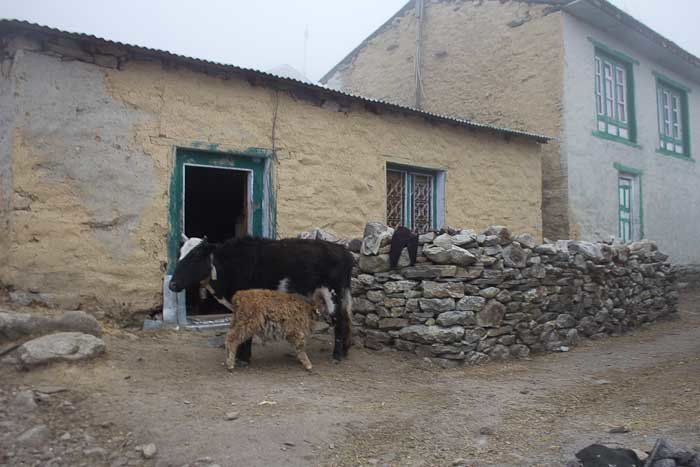
When the Khunde hospital opened in 1960, the first hospital in the region, learning disabilities and goitre from iodine deficiency were rife, along with a range of preventable vaccinable diseases, among them polio.
After over 50 years of foreign management, it’s now run by a Sherpa doctor with a Sherpa team, and operates subsidiary outreach clinics up in the mountains.
Foreigners pay $50 plus cost of medicines for a consultation – overwhelmingly the issue is AMS (acute mountain sickness, the new name for altitude sickness), caused by ascending too fast. Porters and locals pay 20 rupees, or a little over 20 cents.
A paramedic shows us round, in exchange for a donation. They have a delivery suite, with ultrasound and an old-fashioned incubator for preemies – 95% of pregnant women in the region come here for checkups, some walking seven hours each way to do their antenatal checks (the Sherpa babies we’ve met are, overwhelmingly, rosy-cheeked, chubby and obviously well-nourished, and part of small, well-planned families).
There are a series of long-stay rooms, each with a bed for the patient and a bed for the carer, who will stay with them and prepare food for them. There’s a clinic, their own lab, and a medicine room (they welcome donations of unfinished medicines – and I’m hoping we’ll have plenty left). They’re equipped for minor surgery but don’t like to handle anything major.
We talk about the health problems in the community. Unsurprisingly, the Sherpa, who walk everywhere and eat a largely vegetarian, if high-sugar, diet, do not have a problem with heart disease. There are a lot of lung problems, particularly among older people, who grew up before electricity or smokeless stoves. Children are now fully vaccinated.
“What happens if people need to go to Kathmandu for care?” I ask. As a Westerner, anything more serious than a sprain, a broken limb or a tummy bug will see you evac-ed to Kathmandu on a helicopter (price from $2000 if your insurance won’t cover you at height).
“Well, local people can’t afford helicopters,” he says. “So they need to carry them down the mountain to Lukla. Sometimes they can fold them up and put them in a porter’s basket on their backs with blankets. Sometimes they’ll use a stretcher.”
Zac, who has been reading the posters on the walls, asks in absolute horror, “How do you get pressure sores?”
He is reassured that you need to be immobile.
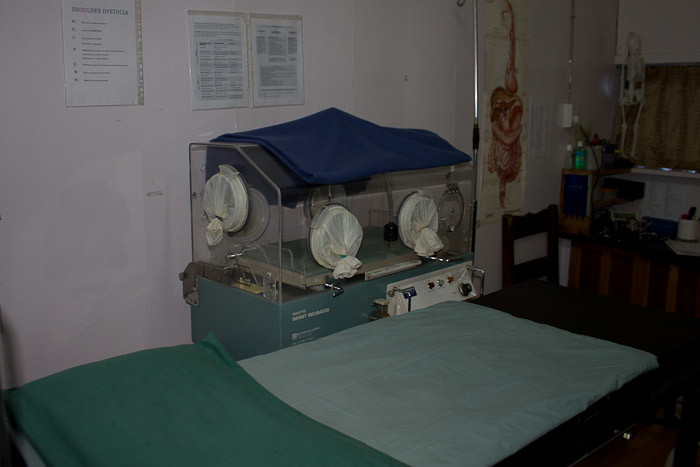
Nir is particularly keen to show us Khumjung High School, which is, as we see from posters all over the mountains, an icon for the community, complete with a large bronze bust of Edmund Hillary square and centre.
It educates children to age 16 and pretty much every block, from the teachers’ accommodation through to the spiffy computer room, the art room, and the blocks for the borders who do not have family they can stay with in Khumjung, bears a plaque commemorating one or another Everest expedition or mountaineering club.
There’s a large, dirt football pitch, a little playground which the younger kids are making the most of, and a bright, Roman alphabet mural: E is for Everest, natch, G is for… “Gautama?” asks Zac, “God, I think,” I say.
It’s here that the kids from higher up in the mountains come to go to school once they pass the primary stage.
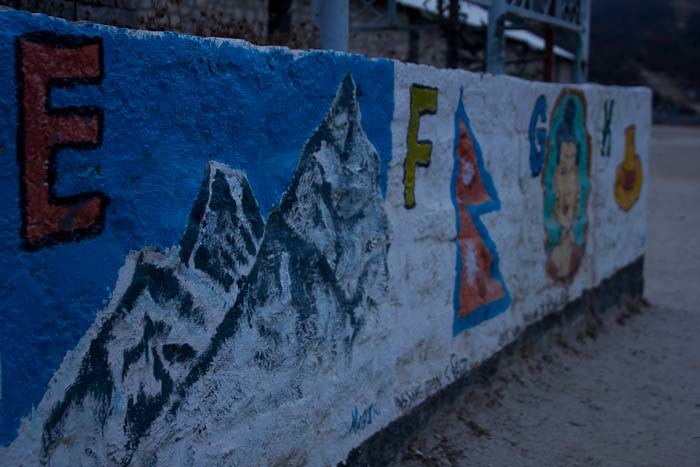
Later that evening, after plates of dal bhat tarkari, the combination of lentil soup, rice and vegetable curry that’s the basic fuel of Nepal, we sit around the central brazier in the cosy main room, lined with high varnished, kneehole tables that remind both me and Zac of school desks, and talk to our host and his mother-in-law about how life has changed in the region, as he feeds cakes of dried yak dung into the fire.
Gathering yak dung and flattening it into cakes is one of the routines of rural life here: the ban on cutting firewood seems well-observed in the lower reaches of the national park, at least.
“Do the kids help?” I ask. (Zac, who thinks that the Sherpa and the Bedouin have a lot in common, has observed that Bedouin children gather camel dung.)
“Not any longer,” says our host. “They need to go to school. So we do it, in the mornings. And animal dung from the forest too.”
“How old is your daughter?” asks grandma, who, despite the rattle of her incurable lung disease, is bright as a button and physically active.
“He’s a son!” Nir explains.
There’s a giggle. I’m taught the difference between tsora (son) and tsori (daughter), and learn that grandma has three kids. I manage to communicate that Zac is twelve, like her grandson.
Dispiritingly, as in Bali, one’s flipping between two languages here: most Nepalis, like most Indonesians, speak their own tribal language in addition to the national language, and up here conversation flips seamlessly between Sherpa and Nepali.
When our host removes the kettle that bubbles constantly on the top of the stove, to store the hot water in a thermos and replace it with new, I take a sniff of the smoke that rises. I want to learn what burning shit smells like.
This is also, very obviously, quite the funniest thing that grandma has seen for years. (Sherpa people are shy about photos, so I’m sorry there’s no portrait.)
The answer, when it’s yak dung and well dried? Nothing. Just…. smoke.
It will take a while before I’m brave enough to overcome my cultural inhibitions about handling this type of fuel and see what it actually feels like, though…
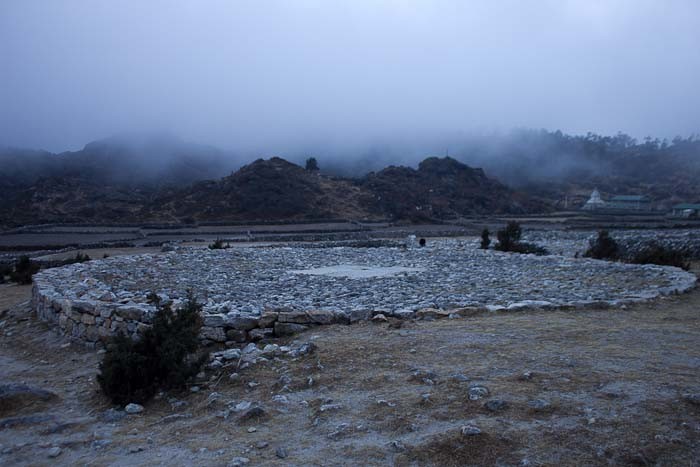
It’s fascinating to hear how life in the villages has changed over my lifetime: the drystone helicopter pad without which none of the lower villages in the Khumbu are complete is only the most obvious sign.
The big influx of tourists began about 13 years ago, in the wake of not primarily the book but the movie Into Thin Air, about the 1996 Everest disaster.
All of the parents and parents-in-law but grandma are dead: two of lung disease, one from smoking, one from life in smoke-filled kitchens and huts, one of cirrhosis and lung disease.
When grandma grew up, of course, there were no schools in the region. Today the grandsons go to school, and will continue to college and hopefully university in Kathmandu: the teenage relative who chatters away on her mobile seems to be finishing her studies at Khumjung school.
“The school’s much better now,” our host explains. “They have different teachers for the different subjects: for languages, for science, for maths…”
“Even for computing?” I ask.
He shakes his head. That’s patchy, he explains. And I realise that, of course, it’s easier for a foreign expedition to fund a one-off building and a bit of second-hand tech than to make an ongoing commitment to a teacher.
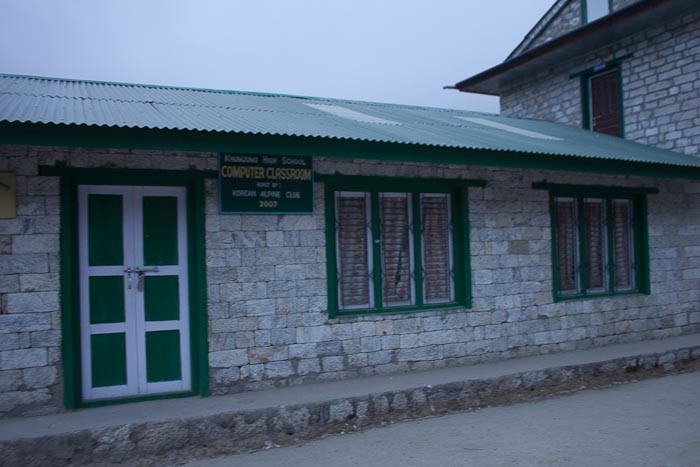
That said, I was expecting, I think, when we set off to the Khumbu, to find a region destroyed by tourism.
But, as Zac and I snuggle up in our sleeping bags, under quilts, socks and thermals, it feels as though the hospitality, dignity and traditional practices of the Sherpa people have been overwhelmingly preserved, and that tourism has brought, in general, wealth, health and education.
The poor still suffer, of course: the tourist dollar has driven up food prices for those without land to produce their own. But there are fewer of them.
In the morning, we wake with sunlight streaming through the thin curtains and warming our little room, and eagles circling overhead.
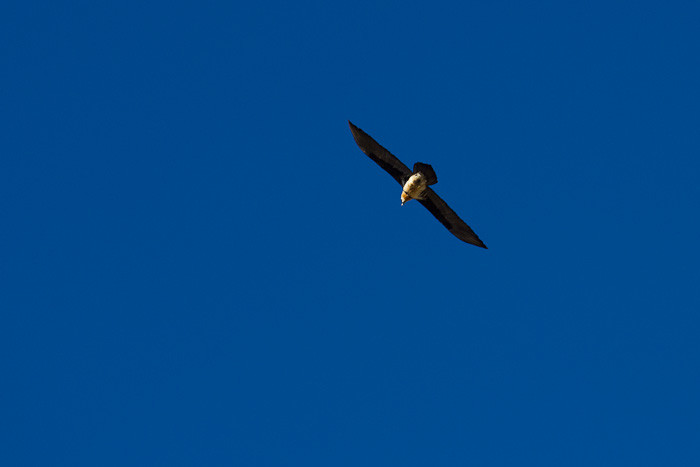
I head to the simple, pristine, indoor squat toilet and realise that I need to break the ice on the bucket from which one flushes.
Oh god, I think. A vertical mile to go, and it’s going to get colder. A lot colder.
And the hot water bucket wash I had yesterday afternoon will most likely be my last for a while.
Thank god, I think, I did my hair…
You can start from Day 1 of our Everest Base Camp trek here. You can read my previous post on Namche and Thame here or the next post in this series here.
If you’re thinking of doing the Everest Base Camp trek, I recommend my Everest Base Camp FAQs.

i love this. our nepal editor has written much about this region, and schools, and hillary. but i love the one about the yeti (http://www.wanderingeducators.com/best/stories/yeti-tourism-preamble.html).
i am glad that education is important! and, that tourism hasn’t overrun. the icy bucket, though… brr!
Oh, and it gets brrr-ier as well…
Looks like I was at the same lodge in Namche as you last month, I have the same photo from the terrace at the Everest View Hotel, went to base camp via Tengboche route, geat experiance back at work in England now looking at your reports with envy.
Thanks, Andy! I have to say, I loved the Gokyo Valley route… Do you mean we were in the Hotel Kamal at the same time?! How funny!
Not at the same time, I was in Namche on the 5th November on the way back down. Enjoying reading your reports looking forward to when you go over the pass.
Yes! I need to catch up on that, but I’ll give that some detail as it’s quite hard to get a description of what it’s like…
Very informative post and well written! I didn’t know about the yeti and I’m glad that tourism has some good impact on the local community over there 🙂
Thanks, Izy. I think the impact of tourism — first mountaineering, then trekking tourism — has been substantially positive for the people round here, although I am sure there are many who’d disagree with me…
Thank you for that skepticism about the yeti skull! As I was reading, I was thinking, what’ll I do if she thinks it’s a real skull of a mythological creature? 🙂
As for the hotel “rack rate,” — I guess that price point is what happens when you’re the only game in town, huh?
I guess! Although there are “luxury” trekking lodges too (which are pretty much like the non-luxury ones, except that you have your own bathroom and when the power holds up you might even be able to flush the loo without using a bucket and manage a hot shower once a year)… It’s quite bizarre, to be honest. We’ve been paying a little over US$2 a night. And the $200 a night places really aren’t THAT different.
Experiencing a new place from the highest point is my first must in a city. In your case, an adventure!
If this trip has resolved as much of my vertigo as I think it has, I might have to join you in that…
Lovely post, Theodora. I can just imagine what the grandma was thinking about you sniffing the smoke from her stove. Too funny.
What amazed me about her was how very insistent she was on continuing to work around the home, including hard manual labour, despite her pulmonary condition, which was quite shockingly bad…
theodora… i love following your adventures. the details of who said what, who’s jaw dropped, your thoughts, a true running journal of your day to day life on the mountain. thank you… i love the opp to share your work, and the contrast of you guys up on that mountain and us, down here in southern cambodia off an island. merry christmas. gabi
Thanks, Gabi! And happy hanukkah to you all.
I love that the highest hotel in the world reminded you of . . . The Shining. Travel is zany.
It was just those loooooong, cold, red-carpeted halls, Terry… And the general air of desolation.
I was happy to see another child experiencing the wonder of Khumbu! I was so lucky to go there in 1972 when I was 10. I actually took a horrible spill in Lukla and was transported by Sherpa for a day afterwards. We made our way to Khunde Hospital to get some care for my mouth which took the brunt of my fall. The care was wonderful and the highlight was staying for a few nights with a local family who had just finished a small guest room off the side of their house. They had a large family with some children younger than me. There was a young boy who performed daredevil moves on the yaks in a corral just outside the home. We drank lovely ghee-tea and were well-fed.
It was an experience I treasure and I know your on will too!
It must have been wonderful in the 1970s. It’s still very beautiful now, but obviously the whole region has become a lot more commercialised. Namche Bazar now has an Irish pub, if that tells you anything!